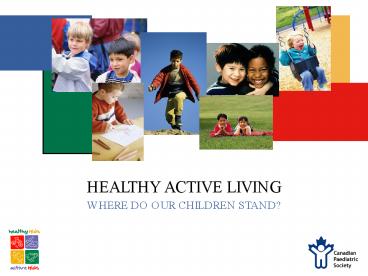HEALTHY ACTIVE LIVING - PowerPoint PPT Presentation
1 / 26
Title:
HEALTHY ACTIVE LIVING
Description:
... children and youth are not active enough for optimal growth and ... Prevention = active healthy lifestyles. Bone Health. Osteoporosis affects 1 in 4 women ... – PowerPoint PPT presentation
Number of Views:538
Avg rating:3.0/5.0
Title: HEALTHY ACTIVE LIVING
1
HEALTHY ACTIVE LIVING
WHERE DO OUR CHILDREN STAND?
2
Physical Inactivity Some Facts
ê 63 of children and youth are not active
enough for optimal growth and development. ê
Activity declines with age. ê Peak decline
takes place in girls age 1415 boys age 1617.
ê Girls are less active than boys. ê Girls
participate in less intense activities.
3
Why Are Canadian Children Inactive?
ê Time pressures ê Television, computer games
ê Inactive parents ê Lack of physical
activity in school ê Transportation ê Cost of
recreation ê Lack of facilities or programs ê
Unsafe environments
4
What Do Canadian Adults Think?
ê Too much time in sedentary activities
(78) ê Children not active enough (63) ê
Physical activity and nutrition equally
important (80)
5
Unhealthy Eating Some Facts
Between 1990 and 1998, students reported ê ?
Nutritious foods ê ? Less nutritious foods ê
1/4 eat candy daily ê 1/4 boys eat potato
chips daily ê Girls consume less whole-wheat
breads and low-fat milk
6
Why Unhealthy Eating?
ê More fast foods ê Soft drinks instead of
milk or water ê Less time to prepare and
eat as a family
7
Health Implications
ê Overweight, obesity, disordered eating ê
Type 2 diabetes ê Hypertension ê
Osteoporosis ê Mental health problems
8
Overweight and Obesity
- ê Estimate between 1981 and 1996, childhood
- overweight doubled
- obesity tripled
- ê Obese children and teens become obese adults.
9
Factors in Juvenile Obesity
ê Large portions and mega meals ê Big
Mac fries 83 of daily fat intake ê
Sedentary living
10
Disordered Eating
ê 43 girls are on a diet or want to lose
weight. ê 1 to 2 girls are anorexic 3 to
5 are bulimic. ê Males are not immune.
11
Type 2 Diabetes
ê More than 1.8 million Canadian adults ê
Associated with heart disease, kidney failure,
blindness and limb amputation ê Increasing
in youth 85 with diabetes are overweight
or obese ê Ethnicity and family history
12
High Blood Pressure
ê Associated with obesity ê Continues into
adulthood ê Prevention active healthy
lifestyles
13
Bone Health
ê Osteoporosis affects 1 in 4 women ê over
age 50 ê Bone mineral mass in first 20
years ê Weight-bearing exercise and ê
adequate diet builds bone
14
Mental Health
ê Juvenile obesity ? depression and poor
self-esteem ê Physical activity ?
self-esteem and positive mood ê PA may help
decrease anxiety and depression. ê PA may
reduce smoking, alcohol and drug abuse.
15
Physical Activity and Healthy Eating
Preventionê Healthy diet ê Regular physical
activity ê Family lifestyle changes ê Reduce
television and video time ê Make kids food-ad
savvy
16
Other Benefits of Healthy Active Living
Beyond disease prevention ê Psychological
well-beingê Self-confidence ê New skills ê
School performance ê Friends
17
Canadas Food Guide to Healthy Eating
18
Healthy Eating Key Concepts
1. Enjoy a variety of foods from each group
every day. 2. Increase cereal fibre, fruits and
vegetables. 3. Choose lower fat foods more
often. 4. Select water rather than juice or
soft drinks. 5. Eat fewer snacks containing
sugar. 6. Eat regularly (at least three meals a
day). 7. Balance eating and physical activity.
19
Canadas Physical Activity Guides for Children
and Youth
1-888-334-9769/ www.healthcanada.ca/paguid
e
20
Physical Activity Key Concepts
Increase active time, starting with 30 minutes
MORE per day.Reduce non-active time, starting
with 30 minutes LESS per day. Month
Increase Daily Decrease Daily
PA
Non-Active Time1 30 minutes
30 minutes2
45 minutes 45 minutes3
60 minutes
60 minutes4 75 minutes
75 minutes5
90 minutes 90 minutes
21
The Battle Is Not a Solo Fight
22
Recommendations for Home
ê Family activities ê Healthy meals
together no mega meals ê Active
chores ê Skill development ê
Spontaneous play ê Healthy snacks ê
Restrict non-active time
23
Recommendations for School
ê Quality Daily Physical Education
(QDPE) ê Recess ê Healthy eating in schools ê
Schools open for family activities
www.cahperd.ca
24
Recommendations for Transportation
Walk or cycle ê To and from school ê On errands
and visits The Walking/Cycling School Bus
www.goforgreen.ca
25
Recommendations for Community
ê Make a connection. ê Ask about
barriers. ê Support community events. ê Get
involved.
26
(No Transcript)































